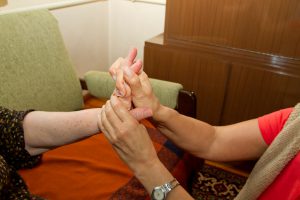
 Integrative and complementary hospice and palliative therapies add an extra dimension of care to hospice’s commitment to nurturing the mind, body, and spirit. These therapies are tools that enhance the hospice team’s (nurse, social worker, spiritual support counselor, among others) ability to promote comfort and support for patients and their families.
Integrative and complementary hospice and palliative therapies add an extra dimension of care to hospice’s commitment to nurturing the mind, body, and spirit. These therapies are tools that enhance the hospice team’s (nurse, social worker, spiritual support counselor, among others) ability to promote comfort and support for patients and their families.
These approaches have essential comforting value to those coping with the end of life and are provided by staff and volunteers.
The benefits of integrative and complementary therapies translate into improved quality of life. Samaritan offers massage therapy, music therapy, pet therapy, and aroma therapy.

A trained massage therapist can provide a touch that brings relaxation, comfort, and connection at a time when people are most likely to feel isolated and fearful. Many patients show improvements in emotional distress, nausea, anxiety, and pain.
Betty Lou was feeling hopeless before she called Samaritan. But, she quickly realized that hospice care isn’t only for the last few days of life. The 81-year-old decided to stop curative treatments for her breast cancer. As part of her plan of care, her hospice nurse recommended massage therapy.
The massage therapist provides gentle therapeutic touch that encourages the natural drainage of lymph fluids that is causing swelling of her left arm. It also alleviated the pain in her neck and back that is a side effect of her cancer. Learn more about massage therapy at Samaritan.

Music is a powerful medium. Music therapists work with patients to address their physical, emotional, cognitive, spiritual, and social needs through individualized treatments like creating music, singing, movement, and listening.
As an integrative hospice therapy, music can make a difference between withdrawal and awareness, between isolation and interaction, and between chronic pain and comfort.
Robert is 72 years old and living with heart failure. He doesn’t say much and his appetite isn’t what it used to be. He’s anxious about his diagnosis and worried about being a burden on his family. He even told his best buddies to stop visiting on Thursday afternoons – a standing date they’ve had for more than 7 years.
He used to love listening to The Rolling Stones. Now he rarely plays the old records in his collection. Robert is depressed and withdrawing into himself. Because of this, and the emotional benefits of music, his hospice social worker refers him to his hospice team’s music therapist for a music therapy assessment.
In time, Robert’s reminiscing dials down his anxiety about impending chest pain and temporarily eases his shortness of breath . . . continued.
Learn more about music therapy at Samaritan.
 Dogs have a long-standing history of providing faithful companionship. These loyal animals are one of the best sources of comfort for any human – including hospice patients and their families. That’s where Samaritan’s complementary hospice pet therapy comes in.
Dogs have a long-standing history of providing faithful companionship. These loyal animals are one of the best sources of comfort for any human – including hospice patients and their families. That’s where Samaritan’s complementary hospice pet therapy comes in.
Certified hospice therapy dogs can provide a wide range of physical, emotional and social benefits to patients and their families.
For instance, when Hank, a five-year-old golden doodle and hospice therapy dog, visits with Mia*, it prompts her to reminisce about her first dog, Snowball. She relishes the memories of playing with the tiny white terrier as a fifth grader. Each stroke of Hank’s fluffy coat brings her joy and helps her forget about illness. Learn more about pet therapy at Samaritan.
 Thanks to the Community Generosity
Thanks to the Community GenerosityThough not required or covered by Medicare, Medicaid and many private insurers, the services of Samaritan’s hospice-trained integrative and complementary therapists are made possible through generous donations to Samaritan. Donate Now >>